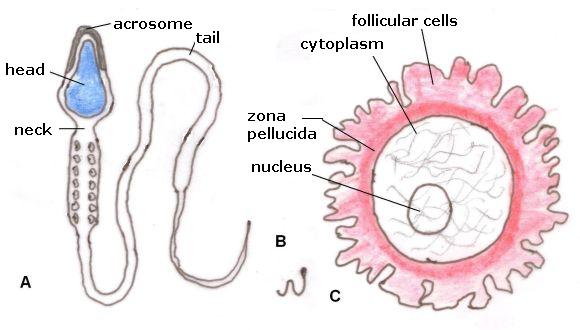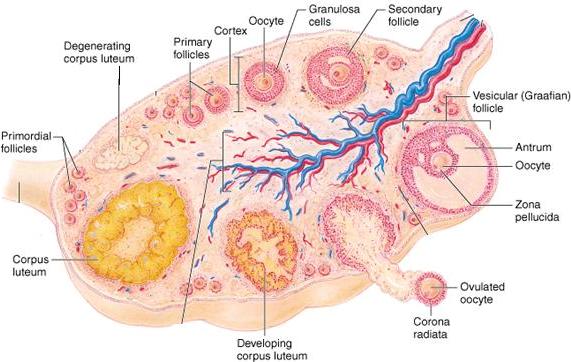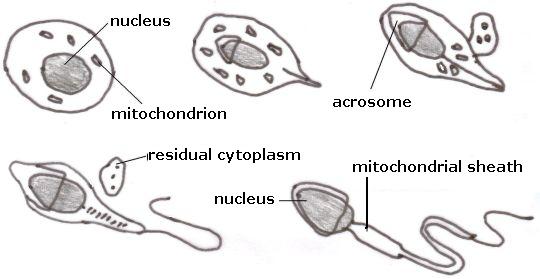
Man does not become human,
but is always human.
Erich Blechschmidt
The human egg cell and sperm
For a conception an egg cell and many sperm are needed. When the cells find each other, they fuse after a while and the chromosomes come together. Then the zygote (= fertilized egg) is formed and can begin to divide. Phenomenology gives us the characteristics of the ovum and sperm. There are no cells in humans that are so different and yet belong so much together.
The ovum and sperm
Size and shape
The egg cell (or ovum, or oocyte) is the largest human cell. She measures 0.15 to 0.2 mm and is just visible to the naked eye. She is also the roundest cell, she is almost perfectly round (Fig. 4). She therefore has the largest volume in relation to her surface. The cell consists of a large amount of cytoplasm (= cell fluid) in which the nucleus is dissolved (and therefore invisible) until just before conception.
Sperm cells are the smallest human cells. They are no more than a nucleus with a small amount of cytoplasm, some mitochondria (the energy suppliers of the cell) and a long tail. They have hardly any content and are the straightest cells.
It is not strictly true that they are the largest and smallest cells. In the spinal cord there are larger cells, in the small brains smaller cells. This does not affect the principle. The difference between ovum and sperm remains enormous.
Egg cell and sperm are each others opposite. Large versus small, round versus straight, cytoplasm versus nucleus. The differences are great, at the same time they belong together if we perceive the ovum as a sphere and the straight sperm as the corresponding radius.

Figure 4. Spermatozoon (A) and ovum (C). B shows the sperm at the same scale as the ovum
Mobility
The cytoplasm of a normal body-cell is in movement, the nucleus is not. The two gametes (= germ cells) show different features. The egg cell consists primarily of cytoplasm, she is internally mobile. The nucleus is outspread, the chromosomes are unwound (not folded up). The cell is internally active and mobile. The sperm cells have hardly any cytoplasm and are concentrated in their nuclear DNA. They have a crystalline structure. These cells are internally structured and rigid.
In contrast, the ovum is externally not active. After her release, she is passively moved by the fluid-flow in the oviduct (uterine tube), while the sperm cells are active, using their tails to swim against the stream of fluid in the oviduct. They are externally active and mobile.
The ovum is internally mobile and externally passive, this is a polarity. The sperm shows the opposite: internally passive and externally mobile. Egg cell and sperm have a polarity and are opposite to each other, we see a double polarity.
Metabolism
An egg cell is a metabolically active cell; substances are absorbed and released. E.g. nutrients are absorbed, substances that affect the uterus and substances that attract the sperm are released. An egg cell lives only 12 to 24 hours in her own environment and cannot be preserved. The egg cell can easily be destroyed. She is an active cell and open to the environment.
Sperm cells do not absorb or release substances. There is no interaction with the environment. They live about 3 to 5 days in the womb and can be preserved and frozen at temperatures below 60 °C. They are not easy to destroy. They are closed off from the environment and metabolically passive.
The open and vulnerable state of the egg cell is polar to the closed and robust state of the sperm cells.
Since several years an ovum can be frozen by vitrification, a process whereby water is removed and replaced by a concentrated liquid, leaving no freezing crystals, which can damage the chromosomes.
Number
For a conception one ovum and millions of sperm are required. The one ovum is worth as much as all those millions of sperm. A man with less than 20-40 million sperm in an ejaculation is barren. Such great numbers are necessary because most sperm do not reach the ovum. Also, for a conception more than one spermatozoon is necessary. See the page Conception.
The ovum is alone and the sperm are with millions. One sperm cell is nothing, one ovum determines everything. One is polar to millions. One comprises everything, it is all there is, whereas the millions of sperm cells are infinitive, have no importance on their own.
Location
The egg cell develops in one of the two ovaries in the warm abdominal cavity, the sperm develop in the testicles just outside the body in a relatively cold environment.
The ovum develops in warm- and sperm in relative cold conditions.
Development
Egg cells are produced well before birth in a huge number of so called primordial egg cells (primordial oocytes). From the beginning on, there is a continuous process of dying, so that at birth 2 million (!) are left. That process of dying goes on after birth. At the onset of puberty there remain about 40,000 ova. Then every four weeks a number of them begin a process of maturation. Of these, only one (sometimes two or three) ovum matures, the rest dies. In total about 400 ova mature (13 per year for 30 years). At menopause, no primordial egg cells are left.
In men, a very different process is going on. The first sperm cells are formed only from puberty on, before that they are not produced. Then the production goes on and on and never stops, hundreds per second, millions each day. Sperm cells are constantly being newly formed.
Egg cells are old cells that became mature. Primordial oocytes are in a process of dying. Sperm cells are newly formed and are young. The maturation process of ova is an expiring process, it stops. The formation of the sperm is a vital process, it never stops.
Maturation
From a primordial oocyte only one mature egg cell develops. During meiosis the rest of the mass of the nucleus is excreted as polar bodies. The cell grows during maturation, the amount of cytoplasm increases. During ripening the ovum moves from the centre of the ovary to the edge (Fig. 5).
From a primordial spermcell four sperm cells develop. The cytoplasm is eliminated, the cell is getting smaller. When some cytoplasm stays behind, the sperm cell cannot swim well and cannot reach the egg cell. Sperm cells are produced at the edge of the testis and stored inside.
At egg cell maturation the focus is on one cell, that expands in volume. Sperm cells show concentration of material and expansion of the number. Egg cells move from the inside to the outside, sperm cells from the outside to the inside.
Conclusion
In appearance and processes egg cell and sperm are mutually antagonistic, each others opposite. Large versus small, internally - versus externally active, old versus young, concentration versus expansion, etc. During maturation of these gametes two cells are formed which differ maximally and seem to go to extremes in their individuality. The development and maturation show increasing divergence, a process of polarization.
When they are mature, ovum and sperm can come together and resolve the polarity in a conception, so that a new human being can be born, that has all the cell shapes that lie between the two extremes. If not, there is no viability, and then they die.
| egg cell | sperm | |
| size | largest cell | smallest cell |
| shape | round | straight |
| inner mobility | mobile cytoplasm | rigid nuclear material |
| outer mobility | passive | active |
| metabolism | active | little activity |
| openness | yes | no |
| number | one | millions |
| produced in | the ovary, inside the body | testes, outside the body |
| temperature | warm | relatively cold |
| when formed | before birth | from puberty |
| age | old | young |
| formed from - until | before birth - menopause | puberty - death |
| maturation | increasing volume | decreasing volume |
| life span | short | long |
| storable | no | yes |
Table 2. Differences between an egg cell and sperm
The development of the ovum
Ova are created as primordial oocytes in million copies as early as in the embryonic stage and their number is gradually reduced. They lie separated from each other in follicles and are surrounded by a layer of nutritive, so called follicular cells. In the primordial follicles (= initial vesicles) they lead a passive existence. In Fig. 5 the development of the egg cell can be seen clockwise from the left (primordial follicles).
- The development begins with the thickening of the surrounding layer of nutritive cells, this is called the primary follicle (= first vesicle).
- This stage leads to the secondary follicle, because in the layer of nutritive cells an antrum (= cave) arises. The ovum grows and gets larger. The follicle produces oestrogen, a hormone that stimulates the wall of the uterus to thicken.
- The antrum grows larger. Around the ovum a layer is formed, called the zona pellucida (= translucent layer). Around it are the nutritive cells in the corona radiata (= radiating wreath). The growth of the ovum continues. The wall of the uterus continues to thicken.
- Then the ovum is shot away into the abdominal cavity. There is a moment when the ovum floats freely in the abdominal cavity. Then she will be collected by the fimbriae of the oviduct. The interception is an active process, the oviduct moves to the ovum. The remaining cavity in the ovary is called the corpus luteum (= yellow small body) that makes progesterone, which also plays a role in the thickening of the uterine wall, so that the fertilized ovum can implant. When a fertilization does not occur, then the thickened wall comes loose and menstruation occurs.

Figure 5. Oogenesis, the development of the egg cell in the ovary (from the Internet)
Konig (1986) gives a similarity between the development of the ovum and the evolution of the earth, as it is described by Rudolf Steiner in Anthroposophy:
1. The egg is surrounded for many years by tissue of the ovary. He compares this to the Warmth Stage of the earth, or the Saturn Stage.
2. The nutritive cells thicken, and the ovum increasingly stands on her own. He compares this to the Air or Sun Stage of the earth.
3. In the layer of nutritive cells the fluid-filled antrum is created. This is compared to the Water or Moon Stage of the earth.
4. The release of the ovum is compared with the (current) solid stage of the earth. The cell is completely on herself and will either develop or die.
The development of sperm
From a germ, four equal sperm cells are formed by division. Around the nucleus a hard cap is formed, the acrosome (acros = top, soma = body). Then the cytoplasm is ejected and the cell gets smaller. Mitochondria move to the beginning of the tail, that becomes thicker and longer. The cells are stored for about 60 days, after which they are resorbed. If a small cloud of cytoplasm remains with the nucleus, the sperm is badly damaged and will have trouble moving forward.

Figure 6. Spermatogenesis, the development of sperm
Based on:
- Van der Wal, J., 2003. Dynamic morphology and embryology. In: Bie, van der G & M. Huber, Foundations of anthroposophical medicine. Floris books, Edinburgh.
- Bie, G van der, 2001. Embryology. Louis Bolk Institute, Driebergen.
